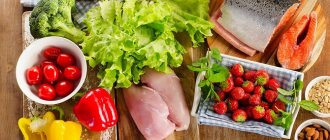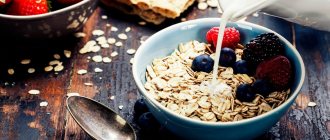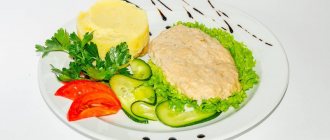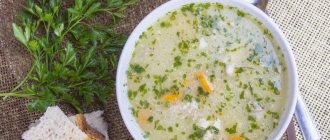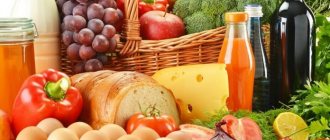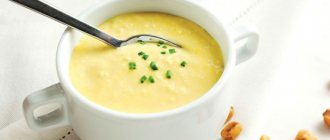In the structure of overall mortality, diseases of the cardiovascular system occupy a leading place. Therefore, it is important to carry out preventive measures and explain the need for the use of comprehensive treatment programs (diet therapy, drug treatment and dosed physical activity) among the population. The key to treating heart and blood vessel diseases is nutrition.
The diet, which is used to treat the cardiovascular system, was developed by Manuil Pevzner, a Soviet scientist, professor and nutritionist. Familiarity with the technique will allow you to minimize the risk of heart attack, stroke, atherosclerosis, and more effectively undergo rehabilitation for existing diseases of the cardiovascular system.
General characteristics of dietary table No. 10
Diet No. 10 fully satisfies a person’s physiological needs for nutrients and energy while limiting the consumption of salt and liquids. The caloric content of the diet is normal, increased consumption of vitamins, minerals, and plant fiber is provided. The diet involves limiting and eliminating foods and dishes that have a stimulating or irritating effect on the nervous and cardiovascular systems, as well as on the kidneys (extractives, essential oils, spicy, salty, tonic, alcoholic drinks). Food is prepared steamed, boiled or baked without salt. Salt is given to the patient in the amount of 3–4 g. Diet No. 10 provides for fractional meals 4–6 times a day. The last meal is 2-3 hours before bedtime.
Proper nutrition for atherosclerosis
A completely insufficient measure is a balanced menu, with the inclusion of foods with a certain ratio of vital components - microelements, vitamins, carbohydrates and proteins. Of course, such a menu will bring positive results. But the main task for patients with atherosclerosis is to strictly calculate the calorie content of the daily diet and follow the calorie standards established for their group. Calorie content is determined based on the following parameters:
- patient weight;
- age;
- Lifestyle;
- professional activity taking into account physical activity (the nature of the work performed and its intensity).
Considering that atherosclerosis is one of the main causes of death in people all over the world, you should carefully follow the recommendations of your doctor and nutritionists.
Chemical composition and energy value of dietary table No. 10
Proteins: 85–90 g (including 45 g animal proteins). Fats: 70–80 g (including at least 30 g of vegetable fats). Carbohydrates: 300–350 g. Daily calorie content: 2,200–2,400 kcal. Free liquid: 1.5–2 l. Table salt: 6–8 g Vitamins: retinol (A) – 0.3 mg, riboflavin (B2) – 2.5 mg, thiamine (B1) – 1.7 mg, nicotinic acid (B3) – 22 mg, ascorbic acid acid (C) – 150 mg. Macroelements: sodium – 2.6 g, potassium – 4.2 g, calcium – 1 g, phosphorus – 1.8 g. Microelements: iron – 6 mg. Optimal food temperature: from 15 to 65 degrees Celsius.
Nutritionist's recommendations
- The main diet should consist of high-density lipoproteins with a sufficient amount of digestible vitamins.
- Food is cooked mainly by steaming without the use of fat. Vegetable oil is used for dressing salads and other dishes.
- When cooking broth from lean meat, the cooled fat is skimmed off the surface.
- Fried foods, as well as canned foods and pickles, including home-made and factory-made canned meat and fish, are completely excluded.
- Smoked products are prohibited.
- There is no need to add salt during the cooking process. Table salt is used in small quantities when serving the dish.
- For home baking, use chicken protein, not yolk.
- The daily diet is five meals a day. This technique allows you to avoid overeating and minimize the feeling of hunger between meals.
Find out the causes of excess weight and ways to quickly lose weight
Sign up for a free initial appointment with a nutritionist!
The daily menu of a patient with atherosclerosis consists mainly of protein foods:
- lean meat;
- low-fat cottage cheese;
- fish.
Important! The volume of each of the above products is about 150 grams (daily).
What do protein-rich foods do?
With their help, you can create a long-lasting feeling of fullness. The human body takes longer to process such products. Therefore, repeated meals after a short period of time are not required.
Plant sterols in the diet of patients with atherosclerosis
Sterols are components that are contained in:
- in natural vegetable oils;
- in nuts;
- in legumes;
- in cereals.
Thanks to sterols, excess cholesterol is not absorbed into the bloodstream. Thus, foods high in sterols become part of a comprehensive program for the management of patients with vascular atherosclerosis. The daily norm of sterols is about two grams.
Recommended products and dishes of the diet table No. 10
Bread: wheat bread (including salt-free), grades 1 and 2, yesterday's bread or dried, wheat crackers, savory cookies and savory pastries. Soups: vegetarian soups (with vegetables, cereals, fruit, borscht, beetroot soup), milk soups. Normally, soups are served in 1/2 servings; in case of severe swelling, they are excluded. Meat dishes: lean beef, veal, lamb, pork, as well as chicken, turkey, chicken, rabbit, boiled or baked after boiling - in pieces, chopped. Fish dishes: low-fat varieties of fish, boiled in pieces, chopped, baked; Boiled seafood is recommended. Side dishes: cereals (oatmeal, buckwheat, semolina) in the form of porridges, casseroles, puddings, etc.; Any vegetables raw, boiled, baked are recommended; pasta (preferably diabetic) and buckwheat noodles are allowed; in case of obesity, everything except vegetables is limited. Dairy products: milk, fermented milk products, cottage cheese and dishes made from them; sour cream in small quantities in dishes; mild low-fat cheese. Eggs: no more than 5 eggs per week, soft-boiled or as a steamed egg white omelet. Snacks: aspic, doctor's sausage, salads from fresh and boiled vegetables, vegetable caviar and canned vegetables, mild low-fat cheeses, greens. Sauces: vegetable (including tomato), milk, sour cream, fruit. Sweet dishes: any fresh fruits and berries; sugar (up to 50 g), honey, jam, mousses, jellies, dried fruits. Drinks: weak tea and coffee with and without milk, coffee substitutes, fruit, berry and milk jelly, rosehip decoction, fresh juices, mineral water as agreed with the doctor. Fats: fresh vegetable oil;
fresh unsalted butter – limited.
Diet for vascular atherosclerosis. Basic Rules
Following dietary and lifestyle recommendations is not at all as difficult a task as it might seem at first glance. The patient is required to have discipline and awareness of the importance of following the instructions necessary to maintain health, improve the quality of life in general and further have a positive prognosis. On the subject: How not to eat after 6 pm Doctors' orders include:
- Refusal from meat broths, fatty, salty and smoked foods and semi-finished products and replacing them with healthy dishes (stewed, boiled and baked).
- Regular meals (small portions) – four or more times a day.
- A balanced menu with optimal content of micro- and macroelements, carbohydrates and proteins.
- Limiting table salt.
- Hot spices/condiments are prohibited.
- Including a sufficient amount of fiber-rich foods in the menu.
- Lots of fresh vegetables and fruits.
- Consumption of low-fat dairy products (in doses indicated by a nutritionist).
If you are overweight, patients are required, under the supervision of specialists, to take measures to lose weight by practicing fasting days. Homemade weight loss and dietary nutrition without consulting a specialist is prohibited! Illiterate actions cause harm to the body. On the recommendation of a doctor, it is necessary to completely avoid or significantly limit the following products:
- sugar;
- candies and various sweets;
- mayonnaise;
- store-bought sauces;
- ketchup;
- bakery products made from wheat (white) flour;
- offal;
- red meat;
- sweet carbonated drinks;
- store-bought juices/nectars;
- cocoa;
- canned fish and meat;
- dried fruits (high in sugars);
- strong coffee and tea.
Preference should be given to foods with a low hypoglycemic index.
Diet number 10I
Indications:
- acute myocardial infarction
Purpose of table assignment
- acceleration of recovery processes in the myocardium
- increased blood circulation
- normalization of metabolism
- reducing the load on the cardiovascular system
- normalization of intestinal motor function
Table characteristics
A diet with a decrease in energy value due to proteins, carbohydrates, and especially fats. The volume of food is reduced, table salt and the volume of free liquid are limited. Products and dishes excluded:
- difficult to digest
- causing flatulence
- sweet
- fatty, cholesterol-rich
- extractive substances of meat and fish
Recommended:
- products with lipotropic action
- rich in vitamin C, potassium
- gently stimulating intestinal motor function
Read also: Diet number 2: nutritious nutrition with restrictions
Diet number 10I consists of three diets, which are prescribed sequentially: diet I - in the acute period (first week of the disease), diet II - in the subacute period (second-third week), diet III - during the scarring period (fourth week).
Diet I consists of pureed dishes, in II the dishes are chopped, in III the dishes are chopped and in pieces. Boil foods without table salt, avoid cold dishes (below 15ºC).
Frequency of meals: 6 times a day with diets I and II, 5 times a day with diet III.
Chemical components:
I diet:
- proteins - 50 grams
- fats - 30-40 grams
- carbohydrates - 150-200 grams
- free liquid volume - 700-800 ml
- daily caloric intake - 1100-1300 kcal
- weight of daily ration - 1600-1700 grams
- sodium chloride (table salt) - completely excluded
II diet
- proteins - 60-70 grams
- fats - 50-60 grams
- carbohydrates - 230-250 grams
- free liquid volume - 900-1000 ml
- daily caloric intake - 1600-1800 kcal
- weight of daily ration - 2000 grams
- sodium chloride (table salt) - 3 grams given to the patient
III diet
- proteins - 85-90 grams
- fats - 70 grams
- carbohydrates - 300-320 grams
- volume of free liquid - 1000-1100 ml
- daily caloric intake - 2100-2300 kcal
- weight of daily ration - 2200-2300 grams
- sodium chloride (table salt) - 5-6 grams are given to the patient
Table No. 10I: what is possible, what is not
Table
| Products | Recommended | Excluded from the diet |
| Bread, pastries | I diet: 50 g of crackers from wheat bread, premium and 1st grade flour (or dried bread) II diet: 150 g of yesterday's wheat bread III diet: 250 g of yesterday's wheat bread, if tolerated - replace 50 g with 50 g of rye bread made from sifted flour | Fresh bread, baked goods, pastries |
| Meat, poultry, fish | Exclusively low-fat types. Meat is freed from fascia and tendons, poultry is freed from skin I diet: steamed cutlets, meatballs, meatballs, dumplings, soufflé, boiled lean fish II and III rations: boiled in pieces, steamed and boiled products from cutlet mass | Fatty types of meat, fish, poultry. By-products, sausages, canned food, caviar |
| Eggs | I-III diets: steamed protein omelets, in vegetable broths - egg white flakes | Yolks |
| Milk products | I-III rations: milk - in tea, in dishes. Low-fat fermented milk drinks, sour cream - season soups I diet: pureed cottage cheese, curd paste, curd soufflé II-III diets: curd puddings with the addition of cereals, carrots, fruits, low-fat and unsalted cheeses | Whole milk, cream |
| Cereals, legumes, pasta | I diet: 150 grams of semolina porridge, pureed buckwheat, rolled oats II diet: 150-200 grams of liquid, viscous porridge, 100 grams of semolina casserole, crumbly buckwheat porridge III diet: cereal porridge, buckwheat-curd pudding, semolina casserole with apples, boiled vermicelli with cottage cheese - only 200 grams | Pearl barley and barley, millet, legumes |
| Fats | Butter and refined vegetable oil - in dishes. On diet III - 10 grams of butter on the patient’s hands | Cooking and animal fats |
| First meal | Diet I: vegetable broth soups with the addition of pureed permitted cereals and vegetables, egg white flakes. Total 150-200 grams III-III diets: vegetarian soups with well-cooked permitted cereals and vegetables, limited - weak low-fat meat broth. Only 250 grams | Fatty soups, with meat, fish, mushroom broths |
| Vegetables | Diet I: 100 grams of potato and carrot beet puree as side dishes and separate dishes, mashed carrot-curd pudding II diet: add cauliflower, grated raw carrots III diet: add stewed carrots, beets Total - 150 grams | White cabbage, cucumbers, radishes, radishes, garlic, green onions, legumes |
| Spices, sauces | I diet: excluded II-III diet: to improve the taste of unsalted food - tomato, lemon, sweet and sour fruit juices, 3% table vinegar, citric acid, sauces with vegetable broths and milk, boiled and lightly sautéed onions | Spices |
| Fruits, berries, sweets | I diet: applesauce, mousses, jelly, mashed dried apricots and prunes, 30 grams of sugar or honey II-III diets: add raw soft ripe fruits and berries, baked apples, compotes, jelly, jellies, jams, meringues. Up to 50 grams of sugar | Chocolate, confectionery |
| Beverages | I diet: weak tea with lemon or milk, rosehip decoction, coffee drinks with milk, prune infusion, carrot, beetroot, fruit juices. 100-150 grams per day II-III diets: the same drinks 150-200 grams | Cocoa, natural coffee, grape juice |
Recipes
First meal
Vegetable broth with flour dumplings
Vegetable broth, flour, 2 eggs, milk, potatoes, butter, herbs.
Add the egg and milk to the melted butter, beat well, add enough flour to form a viscous dough. Dip the flour mixture in small portions with a teaspoon into the boiling broth in which the potatoes are boiled, boil for 5-7 minutes. Sprinkle with herbs before serving.
Summer vegetable soup
Potatoes, zucchini, carrots, onions, bell peppers, green beans.
Place bay leaf, allspice, chopped potatoes, beans and carrots into boiling water, after 10 minutes add chopped onions, zucchini and bell peppers. Cook until the vegetables are ready. Serve with sour cream.
Second courses
Chicken cutlets
Chicken meat, white bread, milk, onion, 2 eggs, vegetable oil, flour.
Prepare minced chicken, add bread soaked in milk and onion. Add pepper, chopped herbs if desired, and raw eggs. Knead the mixture well, form cutlets, roll them in flour and lightly fry in a frying pan, covering with a lid.
Fish meatballs in sour cream
Minced fish, onion, boiled rice, egg, sour cream, 2 tbsp. l. flour, herbs.
Boil the rice. Add rice, chopped onion, beaten egg, fish spices (without salt) to the minced fish and mix. Form into balls, sprinkle with flour and place on a baking sheet with vegetable oil and bake. At the end, pour sour cream and keep in the oven for a while. Sprinkle with herbs.
Dessert
Carrot-rice pudding
Carrots, egg, rice, butter, breadcrumbs, 1 tbsp. l. sour cream, baking powder.
Boil the rice. Grate the carrots and simmer, add rice and rub everything through a sieve. Add egg, breadcrumbs, melted butter, baking powder to the mixture. Mix thoroughly and bake in a suitable pan for 30-40 minutes. Drizzle with sour cream.
Fully or partially limited products
Fresh bread, puff and pastry dough, and broths are completely excluded. You cannot prepare soups from legumes, eat fatty pork, duck, goose, cooking fats, kidneys, liver, sausages, canned food and all kinds of smoked meats.
Fatty fish, canned fish and caviar, salted and smoked fish are prohibited. Do not eat fatty cheese and cream, cottage cheese and sour cream. The consumption of radishes, radishes, sorrel, spinach and mushrooms is prohibited. You cannot eat chocolate, ice cream, products with cream, or salty cheeses. Meat, fish, mushroom sauces, mustard, and horseradish are excluded. Strong tea and coffee, cocoa are prohibited.
Dishes made from legumes are limited, as they cause bloating and grape juice for the same reason. If obese , consume grapes, sugar, honey, raisins, and jam in minimal quantities and very rarely.
Table of prohibited products
| Proteins, g | Fats, g | Carbohydrates, g | Calories, kcal | |
Vegetables and greens | ||||
| vegetables legumes | 9,1 | 1,6 | 27,0 | 168 |
| canned vegetables | 1,5 | 0,2 | 5,5 | 30 |
| sauerkraut | 1,8 | 0,1 | 4,4 | 19 |
| pickles | 0,8 | 0,1 | 1,7 | 11 |
| radish | 1,2 | 0,1 | 3,4 | 19 |
| white radish | 1,4 | 0,0 | 4,1 | 21 |
| red radish | 1,2 | 0,1 | 3,4 | 20 |
| black radish | 1,9 | 0,2 | 6,7 | 35 |
| spinach | 2,9 | 0,3 | 2,0 | 22 |
| sorrel | 1,5 | 0,3 | 2,9 | 19 |
Fruits | ||||
| bananas | 1,5 | 0,2 | 21,8 | 95 |
Berries | ||||
| grape | 0,6 | 0,2 | 16,8 | 65 |
Mushrooms | ||||
| mushrooms | 3,5 | 2,0 | 2,5 | 30 |
Nuts and dried fruits | ||||
| raisin | 2,9 | 0,6 | 66,0 | 264 |
Confectionery | ||||
| candies | 4,3 | 19,8 | 67,5 | 453 |
| pastry cream | 0,2 | 26,0 | 16,5 | 300 |
| shortbread dough | 6,5 | 21,6 | 49,9 | 403 |
Ice cream | ||||
| ice cream | 3,7 | 6,9 | 22,1 | 189 |
Cakes | ||||
| cake | 4,4 | 23,4 | 45,2 | 407 |
Chocolate | ||||
| chocolate | 5,4 | 35,3 | 56,5 | 544 |
Raw materials and seasonings | ||||
| mustard | 5,7 | 6,4 | 22,0 | 162 |
| mayonnaise | 2,4 | 67,0 | 3,9 | 627 |
Dairy | ||||
| milk 3.6% | 2,8 | 3,6 | 4,7 | 62 |
| milk 4.5% | 3,1 | 4,5 | 4,7 | 72 |
| cream | 2,8 | 20,0 | 3,7 | 205 |
| sour cream 25% (classic) | 2,6 | 25,0 | 2,5 | 248 |
Cheeses and cottage cheese | ||||
| cheese | 24,1 | 29,5 | 0,3 | 363 |
| cottage cheese 11% | 16,0 | 11,0 | 1,0 | 170 |
| cottage cheese 18% (fat) | 14,0 | 18,0 | 2,8 | 232 |
Meat products | ||||
| pork | 16,0 | 21,6 | 0,0 | 259 |
| pork liver | 18,8 | 3,6 | 0,0 | 108 |
| pork kidneys | 13,0 | 3,1 | 0,0 | 80 |
| pork fat | 1,4 | 92,8 | 0,0 | 841 |
| salo | 2,4 | 89,0 | 0,0 | 797 |
| beef liver | 17,4 | 3,1 | 0,0 | 98 |
| beef kidneys | 12,5 | 1,8 | 0,0 | 66 |
| beef brains | 9,5 | 9,5 | 0,0 | 124 |
Sausages | ||||
| smoked sausage | 16,2 | 44,6 | 0,0 | 466 |
| smoked sausage | 9,9 | 63,2 | 0,3 | 608 |
| sausages | 10,1 | 31,6 | 1,9 | 332 |
| sausages | 12,3 | 25,3 | 0,0 | 277 |
Bird | ||||
| smoked chicken | 27,5 | 8,2 | 0,0 | 184 |
| duck | 16,5 | 61,2 | 0,0 | 346 |
| smoked duck | 19,0 | 28,4 | 0,0 | 337 |
| goose | 16,1 | 33,3 | 0,0 | 364 |
Fish and seafood | ||||
| smoked fish | 26,8 | 9,9 | 0,0 | 196 |
| salted fish | 19,2 | 2,0 | 0,0 | 190 |
| Red caviar | 32,0 | 15,0 | 0,0 | 263 |
| black caviar | 28,0 | 9,7 | 0,0 | 203 |
| canned fish | 17,5 | 2,0 | 0,0 | 88 |
| cod (liver in oil) | 4,2 | 65,7 | 1,2 | 613 |
Oils and fats | ||||
| animal fat | 0,0 | 99,7 | 0,0 | 897 |
| cooking fat | 0,0 | 99,7 | 0,0 | 897 |
Non-alcoholic drinks | ||||
| instant coffee dry | 15,0 | 3,5 | 0,0 | 94 |
| black tea | 20,0 | 5,1 | 6,9 | 152 |
| * data is per 100 g of product | ||||
Reviews and results
This therapeutic diet is balanced, which allows patients to constantly comply with it. In general, the food is well tolerated, but many note that at first it was quite difficult to get used to the reduced amount of salt and the absence of smoked meat products in the diet. Some restriction in simple carbohydrates and salt allows you to lose weight and get rid of excess fluid in the body. These treatment results are reported in reviews.
- “... I’m pleased with the results, since such a low-cholesterol diet helped normalize cholesterol, and sugar also became normal. They prescribed a diet in addition to the pills because my cholesterol was high. Nutritional therapy has helped me lose weight and improve my overall health. I continue to eat this way, but sometimes I break it a little”;
- “... A low-salt diet helps a lot. My result: shortness of breath disappeared, it became easy to move because the excess fluid was gone, and my blood pressure returned to normal. I must say that at first it was difficult to eat unsalted food, I really wanted sausages and ham, salted fish, but I endured everything. In addition, in 3 months I lost 5 kg, although I ate normally”;
- “... I have a heart defect, I am worried about shortness of breath, swelling and high blood pressure. This is my main diet for health reasons. It’s enough to eat salty food for 2 weeks and the swelling returns and it becomes difficult to breathe.”
